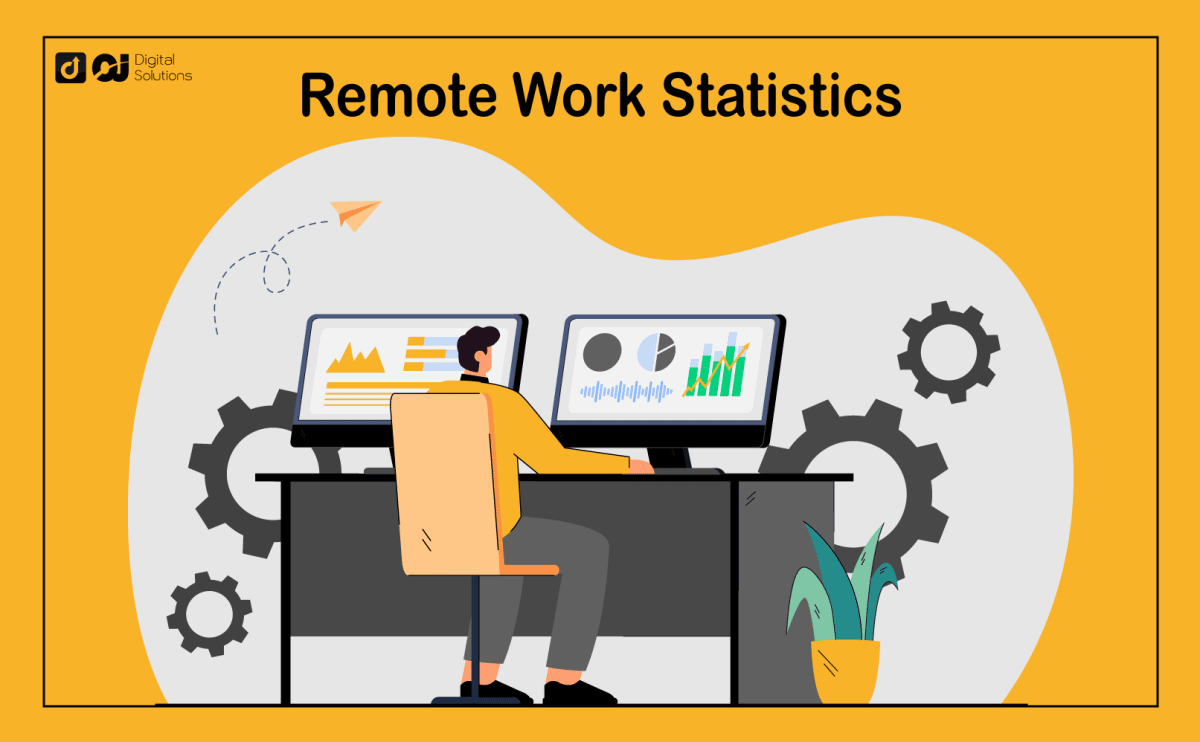Remote work has gained significant attention since the COVID-19 pandemic.
Remote work is now the new normal for millions worldwide, whether entry-level employees or business leaders.
These people perform all their usual job functions—except in the comfort of their homes.
The pandemic made companies realize that remote work is a viable option.
Companies worldwide now support remote work for its many benefits, such as reduced office space costs.
Remote working hasn’t just affected physical office space costs.
In this article, I go over many remote work statistics to show you the impact that remote work has had on the global workforce.
Let’s begin.
Remote Work Statistics
The ability to work remotely isn’t something new.
Many companies already offered employees the option to work remotely before the pandemic.
Remote work has now become an essential part of business operations and has brought several benefits.
All the research indicates remote work has improved work-life balance, boosted job satisfaction, enhanced employee productivity, and increased employee retention.
Companies initially offered the option of working remotely to prevent the spread of COVID-19 when the pandemic first started.
However, businesses have now evolved to operate effectively by allowing employees to work on-site and off-site.
Here are some interesting remote work trends and labor statistics for more information on how remote work has changed the business landscape.
Remote Work Boosts Overall Worker Productivity
Remote work is a significant shift for any organization. 45% of people who work from home say they work more, while 42% say they work the same amount.
Sometimes the office climate favors underperforming employees.
With fewer distractions and more time, employees can be more productive with remote work, benefitting employers and employees.
According to statistics, workplace distractions cost organizations $600 billion every year.
It’s safe to say that having fewer distractions enables more productive working.
Productivity Statistics
Most employees (about 83%) admit working from home benefits their organizations.
While working remotely, 45% of working professionals say they’ve increased their productivity.
For 85% of office workers, working from home means more time spent with loved ones.
32% of work-from-home employees say they have more time since they don’t commute.
Remote Work Means Flexibility
Does remote work mean more flexibility? Absolutely.
About half (48%) of the labor force with flexible work options experience exceptional work-life balance.
Meanwhile, 54% say they have emotional support. Only 36% of people without flexible work options say the same.
Nearly all employees want more flexibility in their work environment, schedules, and work-life balance.
85% of remote workers claim flexibility gives them a better home life by allowing them to spend more time with their families.
The desire for flexibility and better work-life balance has caused many companies’ top talent people to quit their jobs and become freelancers.
A remote workforce saves time by not commuting to work, allowing them to pursue other interests.
Research by the Federal Reserve bank suggests members of the US workforce who worked remotely saved 60 million hours by not commuting.
Remote Workers Are Happy and Healthy
According to research by Owl Labs, employees who worked remotely were happier and more loyal because they had more time to pursue their interests and hobbies.
This data proves that remote work reduces stress and improves mental health.
According to a survey, 88% of employees working remotely said they were happy with the setup.
In a separate study, about 70% of respondents believed full-time remote working would benefit their health.
Remote Work Attracts and Retains Talent
According to the 2022 FlexJobs study, 77% of workers chose to work from home due to its benefits.
In the same survey, 44% of respondents claimed they planned to quit and find a new job because their employers required them to work on-site.
The survey also revealed that about 24% of employees who worked remotely believe being able to work from home is essential.
They were willing to take up to a 20% pay cut to work from home, while 21% of workers reported they would give up their vacation time.
According to the Talent Works Survey, 90% of senior executives planned to work from home in 2021, and 70% would remain loyal if given flexible work options.
Cost Saving
Employees who work from home can save up to $4,000 annually.

They don’t need to consider gas, parking, and meal expenses.
Allowing staff to work from home—even if it’s only a few days a week— will give employees significant savings in the long run.
Remote Work Trends

An increasing number of people are considering remote work.
However, many companies were skeptical about their full-time employees working remotely because they couldn’t monitor them.
Technological advancements have enabled companies to operate efficiently with teams that work remotely.
More and more organizations are allowing employees to work from home permanently or offering flexible schedules that include out-of-office and in-office days.
Why Do People Choose Remote Work?
Buffer’s study in 2022 revealed that 61% of workers considered remote work a positive experience.

In the same survey, no employee said remote work was a negative experience for them.
Remote working is the only option for many job seekers who are terminally ill or with a disability.
Is Remote Work Effective?
According to an Owl Labs study, remote work helps people stay in their jobs longer.
Ergotron’s study sampled about 1,000 full-time employees and discovered that people’s health improved as they acclimated to remote work.
Here are some highlights of the study.
- About 56% of workers reported their mental health improved.
- Remote work has helped people get back in shape. 75% of respondents (about three-quarters) who worked remotely said it made them more active.
- Flexibility boosted job satisfaction for most workers (88% of employees).
- More than 76% of workers said their workplaces offered mental health and wellness initiatives.
Work From Home Accelerates Real Estate Growth
Working from home gives people more options for where to live, reducing the need to move to a big city to get a better job.
Remote workers realize they have more real estate choices.
According to a survey:
- About 65% said they would move.
- 56% desired a better life
- 45% wanted lower housing and living costs.
- 35% wanted a better climate.
Zillow estimates about two million U.S renters have the potential to become homeowners.
Working From Home Has Changed
During the pre-pandemic economy, remote work wasn’t typical, and technology wasn’t as advanced.
Things are shifting because many people no longer need to be in the office full-time.
According to Owl Labs, 16% of businesses are fully remote.

Many companies have replaced traditional on-site work with advanced technology, allowing employees to work from home.
Embrace Working From Home
Remote work stats show that some organizations have lost their top talent by requiring them to be in the office full-time.
Soon, people will not want to work for companies that aren’t fully remote or at least allow remote work a few days a week.
How Many People Work From Home

59% of Americans work from home, which consists of individuals who work under the hybrid model. Before the pandemic, 83% of hybrid groups were home-based.
COVID-19 is no longer the major threat it once was, so employees can now choose to either work on-site or from home.
Despite having workplaces closer to home, 61% of those who began remote work during the lockdown want to remain fully remote and not return to the office.
38% work from home because they lost their jobs.
At the beginning of 2020, 64% of people said they were working from home because their offices were closed.
Meanwhile, 36% said they preferred working remotely versus on-site.
Since 2020, people have chosen to work from home for various reasons.
- 42% of people working under the hybrid model were concerned about COVID-19 recurrence.
- In 2022, 76% of people decided to work from home for no specific reason. This number is up from 60% in 2020.
- 9% of people said they were working remotely in 2020 because they relocated. In 2022, this number increased to 17%.
According to a Pew Research Center report, 57% of employees said it was their first time doing remote work.
They worked from home due to the COVID-19 outbreak.
These remote employees don’t regret their setup due to the following advantages:
- 64% can balance work and life.
- 44% prefer working from home because they can meet deadlines. They have more time to work than those who commute.
- 72% say they have increased productivity since working remotely.
Most people want to work from home. However, it can be challenging for some due to the following reasons.
- Inability to concentrate due to family disruptions
- Having limited home space
- 60% fear being alone
- 14% said they might miss out on a career opportunity while at home
Is There a Future for People Who Do Remote Work?
Since the outbreak began, data scientists at Ladders have been tracking work-from-home productivity statistics across North America.
The company believes remote work is here to stay.
According to Ladders’ forecasts, 25% of all professions in North America will allow for remote work by the end of 2022.
The company also predicts demand for online workers will increase by 2023.
Remote Work Productivity Statistics

Remote work became necessary because of the COVID-19 pandemic.
It was the only option for many companies and businesses to continue operations. Many organizations have now settled for remote instead of on-site work.
According to Upwork, 26% of Americans (one in every four) should work fully remote beyond 2021.
64% of remote workers chose hybrid meetings during the pandemic, while 70% preferred virtual conferences or video calls.
Remote work productivity increased by 13%, according to a nine-month Stanford study of 16,000 employees.
Remote workers also mentioned a comfortable and peaceful environment, adequate breaks, and fewer sick days helped encourage more productive work.
ConnecSolution found that 77% of remote workers who focus on a task and succeed are more productive.
Individuals who work longer hours are 30% less effective than 24% who maintain a healthy work-life balance.
Before the pandemic, only 4% of people in the US had exclusively remote work opportunities.
The percentage of people who worked from home has since risen to 15%.
Prodoscore looked into the top remote productivity tools.
The company compared data from March 2019 to March 2020 and analyzed over 100 million data points from 30,000 Prodoscore US subscribers.
According to the report:
- Phone calls surged by 230%.
- CRM system activity grew by 176%.
- Email activity increased by 57%.
- The number of chat messages grew by 9%.
- Calendar software declined by more than 22%.
- Document access decreased by 26%.
Prodoscore says that fewer meetings meant that employees worked more efficiently.
The company’s report also says productivity grew by 47% from March 2019 to March 2020.
Prodoscore also discovered when people are most productive.
The average worker works from 8:30 AM until 5:40 PM.
Tuesday, Wednesday, and Thursday are highly productive days.
Friday is the least productive day, followed by Monday.
In the same report, 36% of respondents said working from the office is the most productive.
Meanwhile, 60% of people who work from home believe working from home is more effective.
Remote workers are more productive since they don’t have to commute. According to Airtasker, employees who don’t commute can save 8.5 hours weekly or 408 hours annually.
How Working From Home Has Changed

The business landscape will never be the same. It was possible to work from home long before COVID-19, but it wasn’t a requirement or permanent option—until now.
Remote work has evolved in the following ways:
Cloud Storage Management
Working from home has highlighted the importance of cloud-based storage management for businesses.
In the past, the norm was for people to work in the office and save data on multiple devices. Cloud storage has eliminated this and allowed employees to access business data from any device.
Online Meetings
All organizations have regular meetings. The use of video conferencing has grown exponentially since 2020.
Prolonged Workdays
Remote employees tend to have extended workdays. They’re logging into their workspace earlier and staying up late, answering questions and emails.
Parents Are Home Longer
Working from home allows parents to run errands and care for their children during the workday.
More Housing Options
Employees who work from home have more housing options.
They can move closer to their relatives if they want.
Working from home offers people the freedom to live where they want, not where they can, which is a significant shift in the real estate industry.
Changing Homebuyers’ Perspectives
Homebuyers now want houses with Zoom rooms. It’s smaller than an office, and its sole purpose is to host or attend Zoom meetings.
Buyers are now choosing floor plans with two workplaces(one for each spouse).
Freedom
Working from home allows you to work from anywhere—in the countryside, by a lake, or in the woods.
It is now possible to live and work anywhere because of technologies like Zoom, 5G internet, and collaborative work applications.
Levels the Working Field
It’s much better for people with physical disabilities to work remotely.
It removes the need for special accommodations or special requests such as wheelchair access.
Changes Anyone’s Perspective
Everyone’s view of what people can do in the workplace has changed now that more and more employees work from home.
It’s up to people to decide what setup is ideal for them, whether remote or on-site work.
Making Connections is More Challenging
Connecting with colleagues on a deeper level is more challenging when you work from home.
Technology can help, but it lacks the human element. Body language, facial expression, and physical motions don’t translate well online.
Work From Home vs. Office

The “work from home vs. office” debate continues.
Should employees return to the office?
Should they remain remote?
What is the ideal solution?
First, I’ll discuss the pros and cons of remote working.
Pros
- There is more comfort.
- Employees don’t have to commute or spend money on gas to drive to work.
- Employees don’t have to spend hours in traffic.
- Employees can accomplish more with less travel time and office distractions.
- Companies save money on office rental costs.
Cons
- It’s challenging when you don’t have a separate room to work at home.
- Healthcare, retail, and manufacturing professionals can’t work at home.
- Developing a close-knit company culture is challenging because you don’t see other employees in person.
What are the benefits of in-office work?
- People can talk to each other face-to-face, which can help solve problems more quickly. Employees don’t need to conduct meetings; they simply walk up to their colleagues and discuss the issue.
- It’s easier for managers to determine what their employees are experiencing. How enthusiastic and dedicated are the employees? What does their body language communicate?
- Collaborating is much easier. You can get people together in a room and brainstorm ideas.
- Creative juices flow more freely when working closely with like-minded colleagues.
The ideal solution is a hybrid work approach. Companies should allow employees to work at least a few days or hours remotely per week.
There is now undeniable proof that remote work is as effective, if not more effective, than in-office work.
As such, businesses need to be flexible and have the infrastructure to accommodate both.
Remote Work Productivity Study
Digital nomads could work anywhere. Meanwhile, most companies require employees to be physically present in the office. The COVID-19 pandemic changed all that and made remote working a viable option.
Lockdowns forced many firms worldwide to implement changes so employees could work from home.
However, a study by getAbstract found that 43% of Americans still prefer to work from home after the COVID-19 crisis.

Companies must determine whether their employees are more effective at home or in the office.
A Buffer survey found that 97% of workers prefer to work from home part-time.
32% of people working from home think a flexible schedule is the most appealing setup.
However, 27% said they had trouble taking time off work, and 16% said they often felt lonely.
Buffer’s study also revealed that working from home decreased absenteeism and turnover rates.
According to an Airtasker, people who work from home are more productive.
People who don’t commute to work save time and money.
Fewer people commuting means reduced traffic congestion and pollution from motor vehicles.
Monitoring mouse clicks and screen time showed data reflecting remote workers are more productive.
The data shows remote workers only spend 39% of their time not working.
By comparison, people who worked in an office spent 56% of their time not working.

Remote workers are more productive because they don’t have to deal with noisy workplaces or endless meetings.
They can concentrate on work without needing to unwind from the hectic morning commute.
How Remote Workers Can Boost Productivity

Here are some suggestions for increasing remote work productivity.
Take Breaks
It’s common for people who work from home to take fewer breaks than those who work in an office.
However, taking breaks is one of the best ways for remote workers to remain productive.
When remote working, get up and move around throughout the day, especially if you’re exhausted or can’t concentrate.
Try the Pomodoro method.
- Spend 25 minutes on a task.
- Stop at the 25-minute mark.
- Take a five-minute break. That’s the end of one Pomodoro session.
- Take an extended break every four Pomodoro sessions.
- Repeat this until the end of your workday.
This technique helps you relax and focus. Don’t forget to stretch your arms and fingers and take care of your wrists.
Follow a Plan
Time blocking can help you stay productive. Establish a routine to start on the right foot.
Some individuals can only work after breakfast; others work better after morning workouts.
Experiment with different strategies to find what works for you.
Have the Right Tools
Some tasks can be challenging for remote workers to complete at home.
Ensure you have everything you need to work, including collaboration and communication tools.
Have a Daily To-do List
A to-do list helps remote workers systematically complete tasks. It breaks down tasks into actionable steps.
Eliminate Distractions
Impromptu meetings, text messages, and phone calls are major distractions when working remotely.
Maintain focus by setting aside a specific time to check emails, make phone calls, and conduct meetings.
Have a Dedicated Workspace
Remote workers need to set up a dedicated workspace that gives them privacy and allows them to work effectively.
Your space should have adequate lighting, comfortable seating, and an adequately-sized table.
As a remote worker, you should also inform any family members in your household to avoid coming into your area during work hours.
Dress Up in Work Clothes
There’s a connection between work clothes and productivity, even for remote workers.
Dressing in work clothes can increase motivation to complete tasks more quickly.
Prepare a few designated outfits for the week to make getting ready a simple morning routine.
Schedule Your Time Off
It would help if you took time off like any employee working in a conventional office.
Taking time off prevents burnout and allows you to maximize productivity.
The Bottom Line
It’s safe to say that remote work isn’t going away.
Statistics show that remote work has many benefits for organizations and their employees.
If you’ve ever wanted the option of working remotely, now is the perfect time to look at job postings.
Visit my blog for more business and ecommerce tips.






